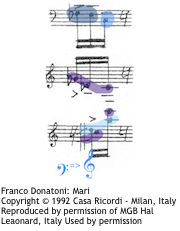Improving the practice and performance of contemporary music
Section 6: f
The second harmonization of Mari I is the center of the piece. This section applies a filter to a certain amount of notes, which in turn changes the harmonization after the key of these notes is altered. A note that is written in the bass clef in the melodic passage, appears as the same note read in treble clef in the harmonic passage.
The first two cells are the corresponding passages in the melody, which causes the dyads to arise in the third cell. The first sixteenth rest displayed in the third cell corresponds to the first note of both previous cells in figure 5, and is the result of a filter that leads into a fragmented rhythm. (cfr. supra). The second dyad (C#5 D5) is a transposition of the Db4 combined with the F3 in the first cell, but now one octave higher. When this note is written on the same place but read in treble clef, it is read as D5. The second dyad is achieved in the same way, while also being transposed one octave higher.

